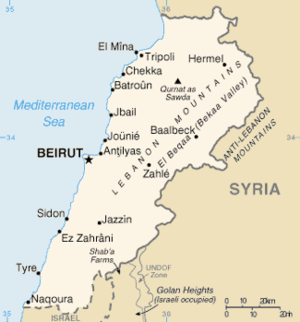2008 Lebanon Conflict
| 2008 conflict in Lebanon | |||||||
|---|---|---|---|---|---|---|---|
 Map of Lebanon |
|||||||
|
|||||||
| Belligerents | |||||||
|
|
|
||||||
| Casualties and losses | |||||||
| 27 killed (see here) |
28-30 killed 1 missing (Hezbollah) 10 killed (SSNP)2 killed (LDP) 1 killed (Amal) |
||||||
| 23 Lebanese civilians killed, 1 Australian civilian killed, 17 soldiers killed 2 policemen killed |
|||||||
28-30 killed 1 missing (Hezbollah)
The 2008 conflict in Lebanon began on May 7, after Lebanon's 17-month-long political crisis spiraled out of control. The fighting was sparked by a government move to shut down Hezbollah's telecommunication network and remove Beirut Airport's security chief Wafic Shkeir over alleged ties to Hezbollah. Hezbollah leader Hassan Nasrallah said the government's decision to declare the group's military telecommunications network illegal was a "declaration of war" on the organization, and demanded that the government revoke it.
Hezbollah-led opposition fighters seized control of several West Beirut neighborhoods from Future Movement militiamen loyal to the government, in street battles that left 11 dead and 30 wounded. The opposition-seized areas were then handed over to the Lebanese Army. The army also pledged to resolve the dispute and has reversed the decisions of the government by letting Hezbollah preserve its telecoms network and re-instating the airport's security chief.
Rival Lebanese leaders reached a deal on May 21, 2008, to end the 18-month political feud that exploded into fighting and nearly drove the country to a new civil war.
On December 1, 2006, a series of protests and sit-ins began in Lebanon, led by groups that opposed the government of Prime Minister Fouad Siniora. The opposition group was made up of pro-Syrian Hezbollah and Amal. A number of smaller parties were also involved, including the Marada Movement, the Lebanese Communist Party and the Syrian Social Nationalist Party. Members of the government are part of the March 14 Alliance, a coalition of anti-Syrian political parties and former militias that include the Progressive Socialist Party, the Lebanese Forces and the Future Movement. The two groups are also divided along religious lines, the majority of Sunnis supporting the government and the Shi'a supporting the opposition group. Druze aligned with Walid Jumblatt support the government, while those allied to Talal Arslan have backed the opposition. The Christian community is divided as well, with Michel Aoun claiming to have 70% of the Christian community's support, based on the results of 2005 parliamentary elections. The opposition demanded that the government resign after Shi'a ministers had left the government in protest against a decision concerning the Hariri tribunal, thus unbalancing the proportional representation of religious groups as stipulated by the Lebanese Constitution. The standoff between the March 14 government and the March 8 opposition resulted in a year-long deadlock over the election of a new President to succeed Emile Lahoud whose term had expired.
...
Wikipedia
